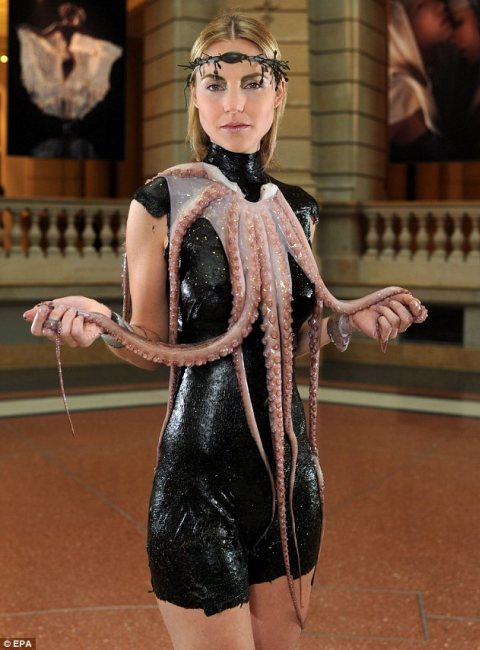American pop singer Lady Gaga wore a dress made of raw beef to the 2010 MTV Video Music Awards, sparking off immense publicity and controversy at that time. Designed by Franc Fernandez and styled by Nicola Formichetti, the dress was condemned by animal rights groups and named by Time as the top fashion statement of 2010.
Lady Gaga may have pioneered the idea of turning what we eat into what we wear, but a Berlin museum has taken the concept to the next level.
But unlike the pop star’s ‘meat dress’, these cuisine creations are meant to be end up being eaten – providing a feast for the palate as well as the eyes.
The bizarre costumes – including octopus tunics, seaweed miniskirts and chocolate dresses – are the brainchild of Michelin-starred chef Roland Trettl.
They are on display at the “Fashion Food” exhibition at Berlin’s Communication Museum (Museum für Kommunikation Berlin), featuring 50 photographs by photographer Helge Kirchberger.
The exhibition hopes to explore notions of consumerism and sustainability, as well as breaking down the boundaries between art and cuisine.
‘The images are not salacious or pornographic but they are erotic and provocative and raise questions,’ museum director Lieselotte Kugler said.
‘This is also a celebration of food. When you think of all the food that is thrown away every year in Germany – including 5,000 tonnes of bread – everyone needs to consider how they approach food and how food is increasingly industrialised in our society.’
Some of the outfits are not just visually tempting, but have also been designed to represent a balanced, nutritious meal.
One work, the ‘Russian Lardo’, teamed a suit made from lean bacon with a scarf of squid ink pasta and a salad head-dress made from lettuce, chillies and cress.
Mindful of the need to avoid wasting scarce resources, Mr Trettl and Mr Kirchberger tried to ensure that their raw materials were re-used.
‘Most of the food was not simply thrown away,’ according to Ms Kugler. ‘The octopus is cooked three to four hours until it’s tender and the pasta can be boiled. Then everyone sits down and has a feast.’
But not all the foodstuffs involved made it to plates, she admitted. One striking outfit consisted of a body suit fashioned from liquid dark chocolate, with a head-dress made of ‘calf net’, fatty membrane from a calf’s stomach.
‘Of course the chocolate had to simply be washed off when they were done, there was no salvaging it,’ Ms Kugler said.
‘You only have about two minutes to photograph it, with a crew of 20 people. After that, it starts drying up and flaking off. It is a unique work of art comprised of the food and the model, the material and the form.’
A book published to coincide with the exhibition features a foreword by eccentric fashionista Vivienne Westwood.
She declared herself keen to try the recipes for turning clothes into meals, but said: ‘I hope someone else will prepare them.’
In the introduction, she compared the works with the famous paintings by 16th-century Italian artists Giuseppe Arcimboldo, whose works often feature human figures composed entirely of fruit and vegetables.
 CY@CY Says Welcome to my dreamscape. Where a Lim is also a Ling.
CY@CY Says Welcome to my dreamscape. Where a Lim is also a Ling.








